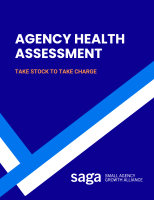Successful agencies work to find the best client matches rather than accepting anyone who walks through the door with a checkbook.
To discover those matches, you must create a specific understanding of your agency’s identity and positioning that helps facilitate those pairings.
The Build to Own mindset requires establishing an identity, including defining your ideal client, and then clearly communicating this first to your internal team and then to the marketplace.
To gauge how well your agency’s identity and positioning is working, you can ask yourself five key questions.
Are you confident about your agency’s positioning and how well you can articulate it?
Adopting a clear focus for your agency can help you to appeal more directly to ideal clients, but it can also help you to improve your profitability as your team becomes more efficient. The deeper experience will also help to produce better results for clients.
Your agency’s positioning should be easily articulated, and it should set you apart from run-of-the-mill “full service” agencies that will work for anyone who has a check that clears.
A clear identity starts with the owner. When someone asks you what your agency does, are you able to quickly and confidently explain it in no more than 2-3 sentences? If not, you probably have some work to do.
If you are not confident about your agency’s positioning: start by making a list of all of your clients from the past 3 years, including characteristics of both the organizations and the key people you work with there. Then note the services you provided and the results you produced for each. Now circle the ones that you want to have more of (and those you want to avoid in the future). That gives you a foundation for describing your identity in a way that is more likely to attract your best-fit clients.
Do all of your employees describe your agency using the same language that you do?
Too often an agency owner may have a clear idea of the agency’s positioning. They may even do a great job of articulating it in pitches or when networking. But the entire agency team should consistently use the same language.
Agencies grow not because of the owner alone, but because the owner has harnessed the power of the full team to represent the agency’s identity.
Many agency employees don’t do a good job of telling their firm’s story not because they are not interested, but because the owner never shared that vision in detail because they handle all of the business development activities themselves. It is vital to incorporate the entire team and ensure that everyone speaks about the agency using the same words.
If you are not confident that your team is describing your agency consistently: start by determining if this is because you haven’t defined your identity well enough or if it is because you have not communicated that identity to the team. Now more than ever, employees want to understand what the agency is doing – and why – so take the time to communicate that and to involve them in the strategic conversations that get you there.
If you ask your clients to explain why they hired you, would they generally give roughly the same answer that you would?
Sometimes we think of ourselves one way, but our clients may see us differently. Are clients hiring you because of your expertise or because you were the cheapest option? Do you describe yourself as a full-service marketing agency, but your clients call you a PR agency?
Ensuring that you and your clients speak about you in the same terms helps to cement your identity and make it easier to attract best-fit clients.
Remember that your identity and positioning are more about how the marketplace views your agency than how you view yourself. If prospects and clients describe you differently, you need to understand the gap between how you are known and how you want to be known.
If you are not confident that clients will describe you the same way you do: start by taking a hard look at your identity and positioning statements to make sure that they accurately reflect reality. If they don’t, then you may need to update either your offering or your messaging. If they do, then you may need to work to better educate your clients about the solution you provide and the results that you produce. Keep in mind that it is difficult to shift perceptions, however. McDonald’s will likely never convince people that it is a fine dining restaurant, no matter how much money they put behind that messaging. The larger the gap between client perception and your desired positioning, the more difficult it will be to achieve, so consider making incremental changes first.
Do you have a clear definition of the criteria for your ideal clients?
It’s one thing to come up with a tagline or even a 1-2 sentence positioning statement, but it is as important to build upon that foundation and develop a clear set of criteria that describes who your ideal clients are (and who they are not).
That means homing in on things like company age and size, the marketing or PR department size, the title of the decision-maker, and more. It might even include more detailed criteria like whether the client has worked with an agency previously or not.
A clear definition of the ideal client helps you to focus your efforts better and avoid clients that might not be a good fit.
As important, your detailed list of characteristics for an ideal client should match with the identity and positioning statements you have developed and communicated as a team. Any disconnect will make your task much more difficult.
To test the clarity, share your definition with a friend or colleague outside of your agency to see if they could use it to name organizations that you agree are good fits.
If you are not confident about your ideal client criteria: start by using the detailed list of clients from the past 3 years described above to map out the characteristics of best-fit and worst-fit clients. Creating a list of must-haves as well as one of yellow/red flags can be extremely helpful in guiding your messaging, marketing, outreach, and qualification activities.
Does your existing client base largely reflect your current positioning and ideal client definition?
It is common for agencies to evolve their positioning over time. The communications landscape changes, the team grows, and perhaps even the owner’s interests shift. That means that there will likely be times when your agency has an identity that doesn’t match the existing client base because you are in a transitional period.
Recognizing the shift that is taking place allows you to adapt your messaging, resources, and other activities to better prepare you for the road ahead.
As noted above, incremental changes to your identity and positioning tend to be more effective so if there is no overlap between how you describe yourself and the clients that you currently serve, you may want to take a fresh look at your approach.
If you are not confident that your client base reflects your identity and positioning: start by making an intentional decision about whether to lean into your current client base or strike a different path. If the divergence has been unintentional, strengthen your prospect qualification steps to gracefully bow out of opportunities that don’t take your agency in the direction that you want to go. While we all accept revenue at times out of necessity, the more intentional we are about those decisions the more successful our long-term growth will be.
Conclusion
Clearly establishing your Identity as an agency is the second step in the AIM-GET Framework because it sets the tone for the subsequent decisions that you must make about Growth, Execution, and Talent. This work builds upon the Ambition that you have defined to ensure that your business is meeting your needs.
Once you have determined that your Ambition and Identity are on the right track, you can begin to move on to other aspects of the business. SAGA’s Agency Health Assessment can help you to look at some of the key drivers of success to identify other areas you may wish to focus on for improvement.










